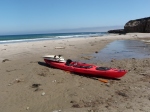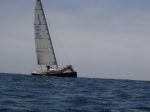Greetings from Los Angeles! We are taking a few days of rest before setting off on the final leg of our trip. Over the past 10 days, we have kayaked 100 + miles from Gaviota down to Santa Monica. The rugged coastal expanse of the Central Coast has finally been replaced by urban sprawl.
Although we were a little uneasy about leaving the Central Coast behind, landing in Santa Barbara meant our first coastal In n’ Out Burger – something we’ve been dreaming about since Big Sur. In the 1830’s Richard Henry Dana suggested the reason his crew was stayed so healthy when sailing off California was the pound or two of beef they ate each day. We had a lot to live up to, but Michael managed with two double doubles.
At UC Santa Barbara, we spoke with Dr. Kevin Lafferty, manager of the adjacent Coal Oil Point Reserve, about threatened marine species and how to shape redwood and agave surfboards. Coal Oil Point Reserve encompasses 58 acres of protected coastline just north of the UCSB, straddling the boundary of Southern and Central California. To the south lies Isla Vista, UCSB’s college town, and to the north the coastline has the more bucolic feel we have grown accustomed to.
We mentioned to Dr. Lafferty that the last sea otter we had seen was just a few miles south of Point Conception. He told us about the monitoring he has done on sea otter populations. Although sea otters populations have rebounded tremendously, the otter has been slow to move south of Point Conception. The otters we saw just around the Point were part of a small group of about 45 otters that make up the southern most colony. Dr. Lafferty is still trying to determine why the otters have slowed their southward proliferation at Point Conception, but he suspects the male otters stick to where the female otters make their homes. Without females south of Point Conception, the male population just doesn’t seem to have a reason to push south.
On that note with a few sly grins exchanged around the table around the table, the conversation took a turn towards surfing. We shared stories about the empty perfect waves we rode to the north, and Dr. Lafferty took us step by step through how to shape surfboards out of agave and redwood. Our eyes lit up as he described the joys of taking something from its creation to its final use. He says he wouldn’t recommend the process to anyone, but the surfboards, much heavier than our modern foam and fiberglass creations, embody a more natural way to enjoy the ocean.
Further south, in the city of Santa Barbara, we spoke with Dr. Jan Timbrook, Curator of Ethnography at Santa Barbara Museum of Natural History, about the Chumash history of the region.
“So did you guys really paddle around Point Conception? I’m curious because the Chumash wouldn’t even think about taking their plank canoes up there”
“Yep we did… and we can see why” we all replied.
Jan spent the next hour with us talking us through the making of the Chumash plank canoe, the tomol. These beautiful old boats were constructed from the same kinds of materials we saw washed up on the beaches. Redwood logs that drifted down from the Central Coast were split into planks using rock tools. The planks were glued together using tar deposits from the beach, a little harder than the stuff that blackens of Santa Barbara beachgoers to this day. To give the canoes a dash of panache, bright abalone shells were crushed up and thrown against the drying tar. The shimmering vessels were said to look like dolphins cresting through the water as they made trips to and from the Channel Islands. We were all blown away at how a seaworthy canoe could be completely manufactured just from what lays around on the beaches of Santa Barbara.
Jan researches Chumash ethnobotany, how the Chumash culture used the local fauna in their everyday lives. I’ve been plagued with some pretty savage cases of poison oak over the last few years, and with Jan’s help and some old Chumash knowledge I may have found a cure. We’ll let you know how well Mugwort leaves work to cure poison oak.
We said our goodbyes to Santa Barbara, and paddled the boats quickly through Ventura to make it home to Los Angeles. I couldn’t be happier to be home. We slept in real beds, ate real food, took real showers, and ate more real food.
They guys have taken to LA like a sprinkle of cinnamon to a soy latte. Michael made a name for himself climbing rope at Muscle Beach, while Lane was spotted sipping Starbucks while strolling down the Avenue of the Stars (sorry buddy I had to).
After a friend John’s car ran out of battery on the Sunset Strip in Hollywood, Lane and Michael had the chance to show their true colors. I pulled up adjacent to the dead Toyota, Lane and Michael jumped out, rigged the cables, and got the car started in less than 30 seconds.
“Positive!”
“YEP”
“Black Negative”
“YEP”
“Grounded”
“Turn it”
“Go Go Go!!”
The BMW’s and Porcshe’s stalled behind us were too dumb founded at the undercover pit crew to even honk.
Sorry for the lack of updates over the last 10 days, it has been difficult to find a free moment in hectic Southern California. We seem to attract the action wherever we pull up, maybe it’s the kayaks, maybe it’s Lane’s carefully sculpted golden hair, or it may have something to do with Michael’s rugged good looks (a little too rugged for a certain West Los Angeles private establishment but that’s a story for another time). Regardless finding time to put pen to paper has been tough as of late.
Thank you to the Montgomery Family, the McGuire Family, the Patterson family, SMDC, Nicole “Tiny Dancer” Rodriguez, Matt “Not-so-tiny Dancer” Goodyear, Antonio Cerruto, Xandra Clark, and Avantika Agarwal, Mikey Sutton, the Black Tie Rebels, Pixiekill, Matt Funk and Will McCabe, and the ravenous mammals in the Santa Barbara Mountains for making this stretch of coast incredible.
And thank you to Santa Monica, Beverly Hills, Hollywood, Venice Beach, and East LA for keeping things lively.



















It Sounds- and looks- like you boys are having tons of fun. Be careful! -Oh and Michael, I did this all on my phone!;)
By: Julianne on August 3, 2010
at 12:37 am
When you get to north county San diego let me know and we’ll paddled out to meet you. Your welcome to stay at the house if you want.
Roderick
By: Roderick on August 3, 2010
at 12:21 pm
hey nice job u do i like it good work ….thanks for sharing
Central Coast Web Design
By: maria on August 4, 2010
at 12:15 pm